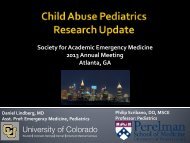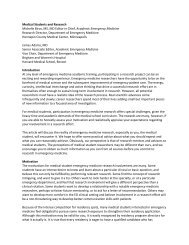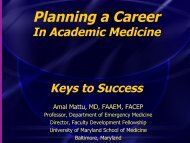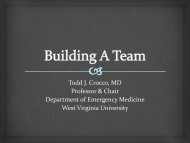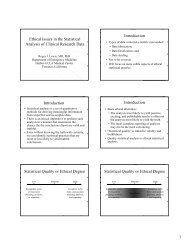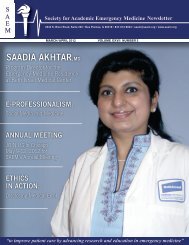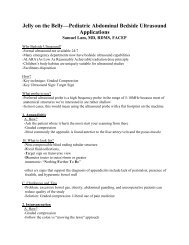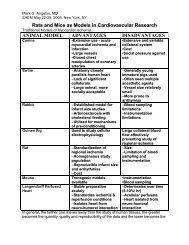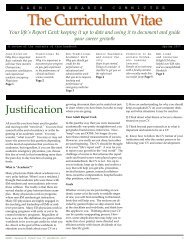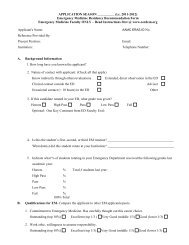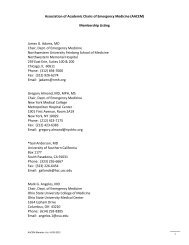March-April 2013 - The Society for Academic Emergency Medicine
March-April 2013 - The Society for Academic Emergency Medicine
March-April 2013 - The Society for Academic Emergency Medicine
Create successful ePaper yourself
Turn your PDF publications into a flip-book with our unique Google optimized e-Paper software.
ETHICS IN ACTION<br />
UNCONSENTED HIV TESTING IN CASES<br />
OF OCCUPATIONAL EXPOSURE<br />
Ethan Cowan, MD, MS 1,2 and Ruth Macklin, PhD 2<br />
Department of <strong>Emergency</strong> <strong>Medicine</strong>, Jacobi Medical Center<br />
Department of Epidemiology & Population Health, Albert Einstein College of <strong>Medicine</strong><br />
An emergency medicine resident gets stuck with a visibly<br />
contaminated, large hollow-bore needle while attempting to<br />
insert a central line. <strong>The</strong> source patient is in<strong>for</strong>med of the injury<br />
but refuses to provide consent <strong>for</strong> HIV testing. A year ago, this<br />
same EM resident became ill and had to be hospitalized after<br />
taking post-exposure prophylaxis (PEP) <strong>for</strong> a prior occupational<br />
exposure. She is concerned about taking PEP <strong>for</strong> the current<br />
exposure and asks if she can use blood already taken from the<br />
source patient <strong>for</strong> other reasons and test it <strong>for</strong> HIV.<br />
Despite significant improvements in occupational safety<br />
standards in health care settings, these scenarios are all too<br />
common. In 2000 the Centers <strong>for</strong> Disease Control and Prevention<br />
estimated that approximately 385,000 needlestick and sharpsrelated<br />
injuries occur every year to health care workers in hospital<br />
settings.1 In EM, a 1998 study of graduating residents found that<br />
56% reported a potentially infectious occupational exposure. 2<br />
<strong>The</strong> real number of injuries is likely much higher because most<br />
exposures go unreported.<br />
Fortunately, in most cases of occupational exposure, source<br />
patients gladly give their voluntary consent <strong>for</strong> HIV testing once<br />
notified of the exposure. Yet, what should happen when source<br />
patients actively refuse or are unable to provide consent <strong>for</strong><br />
additional testing? When source patients refuse or are unable<br />
to provide consent <strong>for</strong> HIV testing, exposed persons lack all the<br />
in<strong>for</strong>mation they need to make a fully in<strong>for</strong>med decision about<br />
initiating PEP.<br />
<strong>The</strong> case vignette brings up the uncom<strong>for</strong>table notion of testing<br />
source patients <strong>for</strong> HIV without their voluntary in<strong>for</strong>med consent.<br />
At first glance, the practice of unconsented testing may appear<br />
antithetical to one of the core ethical principles of our profession:<br />
respecting patient autonomy. However, appealing to wellaccepted<br />
deontological and consequentialist ethical principles<br />
and theories could potentially justify unconsented HIV testing in<br />
limited circumstances.<br />
Deontological ethics focuses on the duties individuals have to<br />
one another. Often these duties can conflict with one another.<br />
Unconsented HIV testing after an occupational exposure is one<br />
such case where the duty to respect autonomy conflicts with<br />
the obligation to prevent harm to others. While controversial,<br />
interference with a patient’s autonomy may be justified if the<br />
potential harm to a third party is significant. This “harm principle”<br />
is one justification that we use as emergency physicians to<br />
hold homicidal patients in the ED, quarantine those with highly<br />
infectious communicable diseases, and notify the partners of<br />
newly diagnosed HIV/AIDS patients. Un<strong>for</strong>tunately, no algorithm<br />
exists <strong>for</strong> determining when potential harms to a third party justify<br />
overriding an individual’s autonomy.<br />
Consequentialist theories, the most well-known of which is<br />
utilitarianism, require that beneficial consequences be maximized<br />
and harmful consequences be minimized. <strong>The</strong> consequentialist<br />
approach requires a calculation of the potential harms and<br />
benefits to all persons affected by an action or policy. In<br />
unconsented HIV testing, the harms and benefits to both source<br />
and exposed persons must be defined and balanced. If harms and<br />
benefits to the exposed person outweigh the harms and benefits<br />
to the source patient, unconsented HIV testing might be justified.<br />
Conversely, if a source patient would suffer a preponderance of<br />
harmful consequences that outweighed the benefits either to<br />
herself or to the exposed person, unconsented HIV testing would<br />
be morally wrong. As with deontological ethics, there is no magic<br />
<strong>for</strong>mula <strong>for</strong> weighing harms and benefits.<br />
Luckily, emergency physicians are not the only ones who have<br />
thought through these issues. As of September 2010, 35 states<br />
had enacted legislation to permit some <strong>for</strong>m of unconsented<br />
HIV testing after an occupational exposure; however, there is no<br />
consistency among the statutes in different states. 4 Variability<br />
exists on when unconsented HIV testing may be allowed, who can<br />
Continued on Page 11<br />
10



